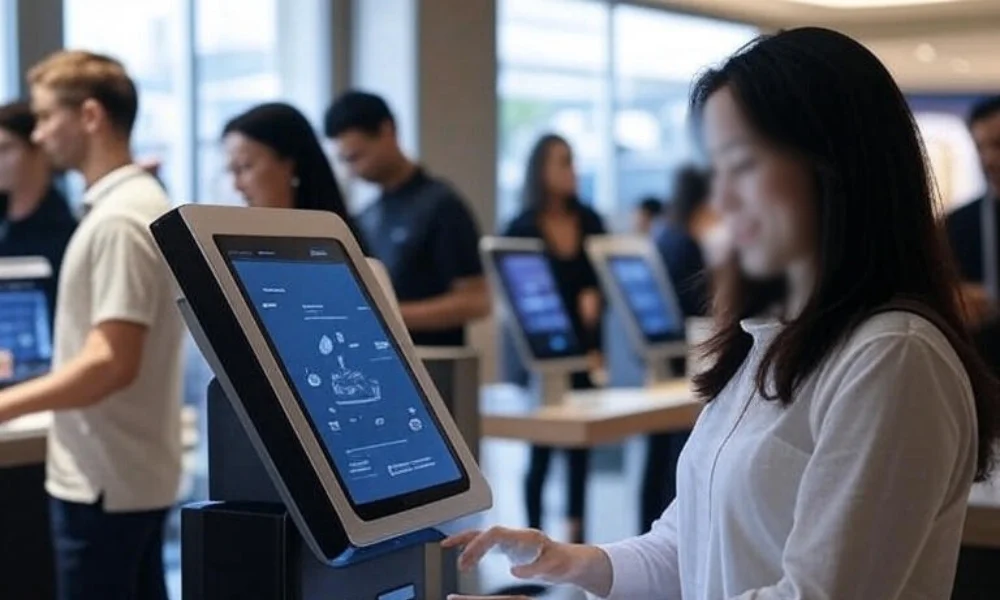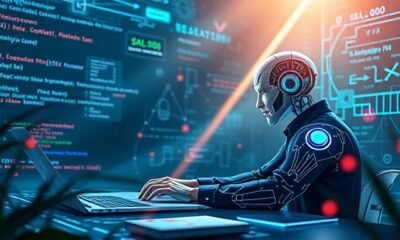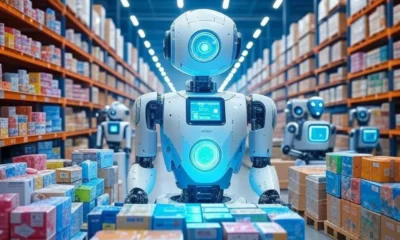Artificial Intelligence
Using AI to Detect Return Fraud and Improve Customer Trust

In my experience daily I have witnessed profit losses and customer confidence lost because of dishonest behavior of returns across retailers.
I will explain how AI return fraud detection finds suspicious patterns protects honest buyers and saves retailers time and money.
Case studies on technologies implementation steps and trust building strategies you should use in my recommend roadmap, I will cover today.
Definition:
AI return fraud detection uses machine learning and computer vision to verify returns flag anomalies and score return risk quickly.
I will also demonstrate how this solution safeguards the merchants as well as enhances the experiences of the honest customers in the stores throughout the United States and increases loyalty.
Knowing about Return Fraud in E-Commerce and Retail:
I have observed that most retailers encounter various kinds of returns of fraud that are a loss of money and victimize the honest customers.
Wardrobing occurs where the purchasers wear out products and send them back as new hence spoiling resale values among the companies. There are even individuals who give out stolen properties back to shops thus making loss prevention to be even more difficult and raising the costs of the whole stores within a short period.
Price switching is also a situation that occurs when individuals alter the tags of products or the barcodes to claim a refund well above what they paid in a shop. Such an approach bypasses simple manual verification and damages profitability of both a local mom-and-pop shop and also in big box stores. A combination of these schemes poses a major problem to all the U.S retailers that desire to maintain fair return policies.
In my opinion, the issue of return fraud is increasing rapidly due to online shopping that facilitates returns a lot easier and makes policies more favorable to the customer. Old systems do not have sophisticated verification features that can be used to spot fraud before it occurs or in the process of returning the products. This is because one can easily beat the manual inspection procedures enabling cheats to exploit the lenient policies.
U.S. retailers are losing billions to fraudulent returns annually which compel the businesses to increase the prices of goods among all parties.
Such additional expenses can usually affect the innocent customers who have to pay more when acquiring the same products they previously purchased.
What are the Ways in Which AI Detects Return Frauds Without Victimizing Legitimate Customers?
I was taught that AI tools analyze the history of purchases by their frequency of returns and purchasing habits and make decisions about anomalies within very little time with fairness. It also verifies contradictions between purchases and returns that is a possible sign of suspicious activity that cannot be noticed by a manual review.
AI minimises the likelihood of false accusation due to human influence or emotions since AI will rely on accurate data-based insights that cannot include bias. When I realize real buyers receive quicker approvals without having to ask additional questions then it shows that AI places fairness at its core.
A retailer that I observe in the U.S. already installed AI fraud detection, and within six months the rate of contested returns decreased by thirty percent. They would be able to approve low-risk returns immediately that led to an increase in satisfaction and send the suspicious cases to go through the human review process to cure the last verification that remained. Reason that this balanced approach achieved success is that this provided them with improved fraud prevention and also more repeat purchases by loyal and honest buyers.
What artificial Intelligence technologies apply in fraud detection?
Such models adapt themselves with time that is to say these models continue to detect the new ways of fraud by themselves without having to constantly update rules manually. I have witnessed how these algorithms can speed up the detection of fraud and maintain high approval rate of real customers with low risk. It can identify counterfeited products or wear on the products by simply comparing with the images of original products instantly.
Predictive analytics also makes use of purchase history and products type to assign a fraud risk score to each return request along with customer behavior patterns. This is a specific solution to short circuiting the process without losing concentration in areas that are really essential.
How AI Dominates Customer Trust, to Avoid Fraud?
Clear product of AI demonstrates to customers that the re-payment checks are equal and fair and rely only on objective figures.
When I describe to the shoppers that AI tracks patterns and not traits they are more confident in the system. Knowing the reason why some returns require additional checks enables clear communication hence avoiding frustration and maintaining trust.
Quicker authorizations of factual customers give them a satisfying shopping experience and entice them to repeat purchases with upbeat assurance. This develops loyalty and customers feel more willingly to recommend the store to others.
Trust is also valued just like fraud prevention since without committed loyal repeat customers, a business could never prosper as it is.
In my opinion, AI is something that allows guarding profits without making returning processes hostile to all. A secure and customer oriented system can transform the issue of returns into an opportunity.
Return Fraud Applications: AI in Real-Life:
A large American clothing-retailing company decreased the level of fraudulent returns by forty percent within a year by integrating pattern recognition based on AI. They also accelerated the time of processing honest returns that achieved higher positive reviews and increased brand reputation in the market. This is the lesson that they got, that security balanced with customer convenience was the key towards long-term success.
One national electronic chain chain deployed computer vision to cost-effectively validate products in returns by more than 50 percent reducing attempts to make counterfeit returns. This saved thousands in costs of manual inspection and this also relieved employees so that time could be utilized in some high value customer service tasks. Basic conclusion of their residency was that AI could be most effective when used in collaboration with trained personnel supervision of complex cases.
Such case studies confirm that it is feasible to measure the outcomes of companies using artificial intelligence in their precious reverse logistic operations methodically. Result was simultaneously an increase in fraud reduction, and customer satisfaction, as well as a decrease in cost of operations in these companies. It reveals how the aim to halt fraud is not tantamount to forfeit good customer experiences.
Steps that Businesses Need to Take to Add AI to Return Processing:
Take a close look at the current return process to learn where the process is most prone to fraud and where customers become impatient. Choose AI tools that are appropriate to the size of your business and which integrate well with your system of managing orders, and stock.Train personnel to be able to interpret AI insights and be able to communicate the information clearly to customers in prospects of returns.
In my opinion, appropriate preparation should make the implementation smooth and very useful as of the first day.
The phased implementation assists with the point of detection and correction of the initial problems prior to the economies of scales of the business.
Which Problems Do Businesses Have in Applying AI to Fraud Detection?
There may be technical difficulties that can be experienced in connecting AI tools to older return management systems or systems that are ERPs. This has the potential to hold up adoption and it becomes difficult to see an entire picture of returns process in a single location. Corporations require their IT support staff to ensure the integration is comfortable and reliable.
Another problem that faces it is that of cost particularly to small companies that have little funds to invest in sophisticated technology. It is manageable to save on cost, undergoing leasing of AI solutions or taking a begging approach. There are still risks of false positives since even smart AI may fail to recognize rare but real behavior of returns. Human validation at edge cases and careful tuning of model is necessary to prevent this happening.
How Will Future AI in Returns and Reverse Logistics Appear?
Blockchain has the potential to keep track of product authenticity throughout the purchase to the return process in real time thus making them more difficult to fraud. It would make customers feel more reassured as each and every case of returns is treated fairly and transparently. It would as well save the processing costs as well as save the punitive checks imposed to the honest customers.
IoT integration may monitor the shipping of a good and its status in a warehouse to the returns center. Situation would assist in automated verification of claims as well as cutting down the manual inspection. It would also establish the better records that would help solve any dispute.
Worldly Wisdom: Wiser Salaries, Relationship To Customers
In the U.S. retail market, AI will play a vital role in being able to detect fraud involving returns without compromising the fairness or the trust of customers. It shields profit, lowers the incidences of fraud, and rewards honest customers with shorter wait times, as well as more enjoyable shopping experiences. This transforms returns into an area of the strength rather than a persistent threat to business.
In my opinion, AI will continuously advance and be a normal aspect of reverse logistics to all retailers. Companies, who will be early adopters will not only have the financial gain but enhanced customer loyalty as well. Future lies in smarter returns and AI has made this dream a reality today. Have you ever got denied an unfair return? Do you suppose AI will make returns more transparent? Do you place your bets on an AI-driven returns procedure?
-

 Artificial Intelligence8 months ago
Artificial Intelligence8 months agoHow to Use Grok AI: A Complete Guide
-

 Artificial Intelligence10 months ago
Artificial Intelligence10 months agoWhat is Artificial Intelligence? A Comprehensive Guide for Businesses and Enthusiasts
-

 Artificial Intelligence9 months ago
Artificial Intelligence9 months agoUnlocking the Power of Artificial Intelligence Tools
-

 Artificial Intelligence9 months ago
Artificial Intelligence9 months agoWhat is DeepSeek? Revolutionizing AI with Cutting-Edge Solutions
-

 Artificial Intelligence5 months ago
Artificial Intelligence5 months agoAI Technologies in Warehouse Automation:
-

 Artificial Intelligence5 months ago
Artificial Intelligence5 months agoPredictive Analytics for Demand Forecasting:
-

 Artificial Intelligence6 months ago
Artificial Intelligence6 months agoMeta’s AI Push: The Standalone Assistant App Set to Rival ChatGPT
-

 Artificial Intelligence5 months ago
Artificial Intelligence5 months agoHow Artificial Intelligence is Revolutionizing Logistics:


